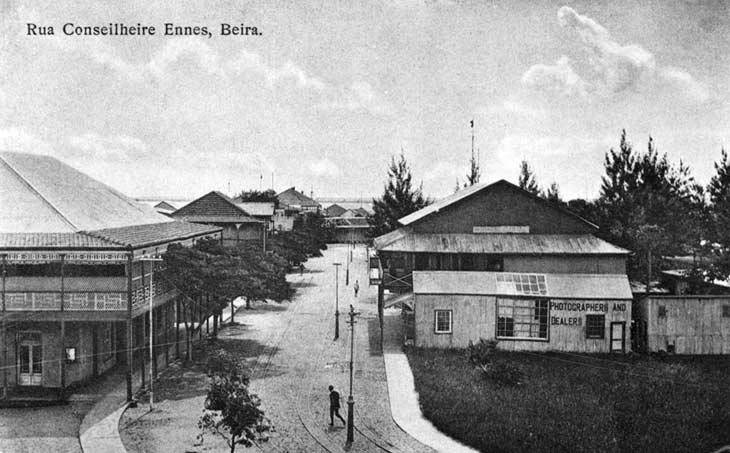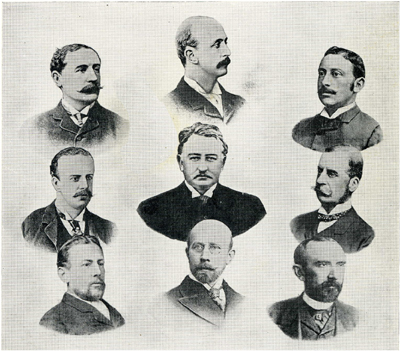|
Massi Kessi
Massi Kessi ( pt, Macequece) is a town near (and almost a suburb of) Mutare in the Manicaland province in Zimbabwe, near the border with Mozambique, on the road and Beira–Bulawayo railway, railway to Beira, Mozambique, Beira. Geography Massi Kessi is located at an altitude of 600m. It is surrounded by the gold fields of Manica Province, Manica. History Massi Kessi was the headquarters of the Portuguese in Manica, who are considered the first Europeans to settle this area of the world (starting in 1520). In the 1880s, as the British are eyeing on Portuguese territories in East Africa, the Kingdom sent the artillery captain Joaquim Carlos Paiva de Andrada to restore the Portuguese outposts scattered in the region. He obtained the authorization to extract and sell minerals, and created the Companhia de Moçambique in December 1888. The company reconstructed a fort in Massi Kessi where it established its headquarters. A conflict took place in Massi Kessi on November 5, 1890 and ... [...More Info...] [...Related Items...] OR: [Wikipedia] [Google] [Baidu] |
Mutare
Mutare (formerly Umtali) is the most populous city in the province of Manicaland, and the third most populous city in Zimbabwe, having surpassed Gweru in the 2012 census, with an urban population of 224,802 and approximately 260,567 in the surrounding districts giving the wider metropolitan area a total population of over 500,000 people.http://www.zimstat.co.zw/wp-content/uploads/publications/Population/population/census-2012-national-report.pdf Mutare is also the capital of Manicaland province and the largest city in Eastern Zimbabwe. Located near the border with Mozambique, Mutare has long been a centre of trade and a key terminus en route to the port of Beira (in Beira, Mozambique). Mutare is hub for trade with railway links, pipeline transport and highways linking the coast with Harare and the interior. Other traditional industries include timber, papermaking, commerce, food processing, telecommunications, and transportation. In addition the city serves as a gateway ... [...More Info...] [...Related Items...] OR: [Wikipedia] [Google] [Baidu] |
Manicaland
Manicaland is a province in eastern Zimbabwe. After Harare Province, it is the country's second-most populous province, with a population of 2.037 million, as of the 2022 census. After Harare and Bulawayo provinces, it is Zimbabwe's third-most densely populated province. Manicaland was one of five original provinces established in Southern Rhodesia in the early colonial period. The province endowed with country's major tourist attractions, the likes of Mutarazi Falls, Nyanga National Park and Zimbabwe's top three highest peaks. The province is divided into ten administrative subdivisions of seven rural districts and three towns/councils, including the provincial capital, Mutare. The name Manicaland is derived from one of the province's largest ethnic groups, the Manyika, who originate from the area north of the Manicaland province and as well as western Mozambique, who speak a distinct language called ChiManyika in Shona (one of the dialect of the Shona language). Manicaland ... [...More Info...] [...Related Items...] OR: [Wikipedia] [Google] [Baidu] |
Zimbabwe
Zimbabwe (), officially the Republic of Zimbabwe, is a landlocked country located in Southeast Africa, between the Zambezi and Limpopo Rivers, bordered by South Africa to the south, Botswana to the south-west, Zambia to the north, and Mozambique to the east. The capital and largest city is Harare. The second largest city is Bulawayo. A country of roughly 15 million people, Zimbabwe has 16 official languages, with English, Shona language, Shona, and Northern Ndebele language, Ndebele the most common. Beginning in the 9th century, during its late Iron Age, the Bantu peoples, Bantu people (who would become the ethnic Shona people, Shona) built the city-state of Great Zimbabwe which became one of the major African trade centres by the 11th century, controlling the gold, ivory and copper trades with the Swahili coast, which were connected to Arab and Indian states. By the mid 15th century, the city-state had been abandoned. From there, the Kingdom of Zimbabwe was established, fol ... [...More Info...] [...Related Items...] OR: [Wikipedia] [Google] [Baidu] |
Mozambique
Mozambique (), officially the Republic of Mozambique ( pt, Moçambique or , ; ny, Mozambiki; sw, Msumbiji; ts, Muzambhiki), is a country located in southeastern Africa bordered by the Indian Ocean to the east, Tanzania to the north, Malawi and Zambia to the northwest, Zimbabwe to the west, and Eswatini and South Africa to the southwest. The sovereign state is separated from the Comoros, Mayotte and Madagascar by the Mozambique Channel to the east. The capital and largest city is Maputo. Notably Northern Mozambique lies within the monsoon trade winds of the Indian Ocean and is frequentely affected by disruptive weather. Between the 7th and 11th centuries, a series of Swahili port towns developed on that area, which contributed to the development of a distinct Swahili culture and language. In the late medieval period, these towns were frequented by traders from Somalia, Ethiopia, Egypt, Arabia, Persia, and India. The voyage of Vasco da Gama in 1498 marked the arr ... [...More Info...] [...Related Items...] OR: [Wikipedia] [Google] [Baidu] |
Beira–Bulawayo Railway
Beira-Bulawayo railway, also called Machipanda railway, Beira-Harare-Bulawayo railway and Beira railway, is a railway that connects the city of Beira, Mozambique, to the city of Bulawayo, in Zimbabwe. It is 850 km long, in a 1067 mm gauge.Mozambique Logistics Infrastructure: Mozambique Railway Assessment Atlassian Confluence. 10 de dezembro de 2018. On the Mozambican stretch, between Beira and , the managing company is |
Beira, Mozambique
Beira is the capital and largest city of Sofala Province, where the Pungwe River meets the Indian Ocean, in the central region of Mozambique. It is the fourth-largest city by population in Mozambique, after Maputo, Matola and Nampula. Beira had a population of 397,368 in 1997, which grew to 530,604 in 2019. A coastal city, it holds the regionally significant Port of Beira, which acts as a gateway for both the central interior portion of the country as well as the land-locked nations of Zimbabwe, Zambia and Malawi. Originally called Chiveve after a local river, it was renamed Beira to honour the Portuguese Crown prince Dom Luís Filipe (titled Prince of Beira, itself referring to the traditional Portuguese province of Beira), who had visited Mozambique in the early 1900s. It was first developed by the Portuguese Mozambique Company in the 19th century, supplanting Sofala as the country's main port. It was then directly developed by the Portuguese colonial government ... [...More Info...] [...Related Items...] OR: [Wikipedia] [Google] [Baidu] |
Manica Province
Manica is a province of Mozambique. It has an area of 62,272 km² and a population of 1,945,994 (2017 census). The province is surrounded by Zimbabwe in the west, Tete Province in the northwest, Sofala Province in the east, Save River in the south, and Zambezi river in the northeast. Chimoio is the capital of the province. The highest mountain in Mozambique, Mount Binga (2436 m), lies in this province near the border with Zimbabwe. The Manica province is divided into nine districts and 34 administrative regions. History The province was located in the old Manica kingdom which probably existed since medieval times and existed until the 19th century. Several larger towns in the region were founded before the Portuguese arrival. In the 8th century the province came under the control of Munhumutapa Empire and had commercial relations with Arab-Swahili traders in the coastal regions. Later it came under the Portuguese influence. The territory of the current province was part ... [...More Info...] [...Related Items...] OR: [Wikipedia] [Google] [Baidu] |
Companhia De Moçambique
The Mozambique Company ( Portuguese: ''Companhia de Moçambique'') was a royal company operating in Portuguese Mozambique that had the concession of the lands in the Portuguese colony corresponding to the present provinces of Manica and Sofala in central Mozambique. The company was established the 11 February 1891 with a capital stock of about 5 million dollars obtained from financiers from Germany, the United Kingdom and South Africa. Isaacman and Isaacman report that the firm was capitalised at 40,000 pounds, and that British and French capital quickly predominated. The concession was granted for a period of 50 years, during which the company could not only exploit the resources and existing manpower (partly through the ''chibalo'' system of forced labour) but also grant subconcessions. The company was granted the exclusive right to collect taxes, but was itself granted a 25-year tax exemption. In return the Portuguese state would receive 7.5% of the company's profits and 10 ... [...More Info...] [...Related Items...] OR: [Wikipedia] [Google] [Baidu] |
British South Africa Company
The British South Africa Company (BSAC or BSACo) was chartered in 1889 following the amalgamation of Cecil Rhodes' Central Search Association and the London-based Exploring Company Ltd, which had originally competed to capitalize on the expected mineral wealth of Mashonaland but united because of common economic interests and to secure British government backing. The company received a Royal Charter modelled on that of the British East India Company. Its first directors included The 2nd Duke of Abercorn, Rhodes himself, and the South African financier Alfred Beit. Rhodes hoped BSAC would promote colonisation and economic exploitation across much of south-central Africa, as part of the " Scramble for Africa". However, his main focus was south of the Zambezi, in Mashonaland and the coastal areas to its east, from which he believed the Portuguese could be removed by payment or force, and in the Transvaal, which he hoped would return to British control. It has been suggested t ... [...More Info...] [...Related Items...] OR: [Wikipedia] [Google] [Baidu] |
Harare
Harare (; formerly Salisbury ) is the Capital city, capital and most populous city of Zimbabwe. The city proper has an area of 940 km2 (371 mi2) and a population of 2.12 million in the 2012 census and an estimated 3.12 million in its metropolitan area in 2019. Situated in north-eastern Zimbabwe in the country's Mashonaland region, Harare is a metropolitan Harare Province, province, which also incorporates the municipalities of Chitungwiza and Epworth, Zimbabwe, Epworth. The city sits on a plateau at an elevation of above sea level and its climate falls into the subtropical highland category. The city was founded in 1890 by the Pioneer Column, a small military force of the British South Africa Company, and named Fort Salisbury after the UK Prime Minister Robert Gascoyne-Cecil, 3rd Marquess of Salisbury, Lord Salisbury. Company Company rule in Rhodesia, administrators demarcated the city and ran it until Southern Rhodesia achieved responsible government in 1923. Salisb ... [...More Info...] [...Related Items...] OR: [Wikipedia] [Google] [Baidu] |





